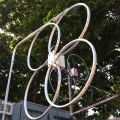v1.419,423: added non-NBFM squelch
v1.419 November 8, 2020
Added a simple RSSI-based squelch for the non-NBFM modes.
See audio tab of control panel. Based on Christoph's squelch from kiwirecorder.
For the non-NBFM squelch the slider represents dB above the median of a number of past RSSI (S-meter) values. There is also a menu of "tail" times -- additional time the squelch is held open before being closed.
The speaker icon now has a third color, white, indicating the squelch is closed (hence no audio). This in addition to red (muted) and green (squelch open or disabled).








Comments
Would double upvote if I could.
kiwirecorder.pywas implemented by its original author and not by me.Regards!
If you're looking for some strong periodic signals to test with: try the mil-com burst sigs around 4.03, 4.79 and 5.75 MHz (EU), HFDL air-com sigs, the ham band FT8 frequencies or SSB contest stations.
Just my 2 cents. Thanks for continuing to be active on development of this great product!
Nick
For the non-NBFM squelch the slider represents dB above the median of a number of past RSSI (S-meter) values.Are the RSSI values used for the moving average from within the passband only? Couldn't this result in the threshold being too high when monitoring a strong, constant amplitude signal? It does not seem to behave this way. Indeed, it seems to work quite well!
Okay, v1.423 makes the record function respect the squelch. The record icon turns white and stops spinning when the squelch is open. It applies to all squelch modes including the original NBFM squelch.
That works, so well it seems like it has always been there.
I'll use that for some elusive signals I've seen in the spectrum max hold.
BTW Forum upgrade is welcome too,
It, of course, is good. But to users of an iOS with systems is higher, than the 14th version, is better to give old WebAudio API (old code for WebAudio API?). Now I experience some difficulties. For example, the «Comp» button has disappeared. Now I can't choose high quality audio. It started with version 1.419.
Not sure what you mean. The Kiwi uses Web Audio exclusively.
The "comp" button is on the same line as the pan slider. But the pan slider is only shown if Web Audio says it has panning capability. This was necessary because some obscure browsers don't support panning (e.g. WebTV). It's a bug that the comp button disappears when the pan slider is absent. But the real question is why all of a sudden the pan capability is missing from iOS. This is true on my iPhone 5S and iPad 2. It's fine on Android. Another bug to chase..
Okay, v1.424 is out which fixes the issue. I had to go back in my notes, but it turns out iOS doesn't support audio panning either. So the only bug is that the comp button needs to be moved to the volume slider line when panning is not available. v1.424 does that.
Yes, everything is fine now. From version 14, audio panning works if you enable the Modern WebAudio API. For some reason it seemed to me that the problem was related to the iOS API.
The problem there is that my iDevices are so old I don't have that option. My iPad runs iOS 9 and Safari has none of the experimental options. My iPhone runs iOS 12 and has about half of them, but not "modern WebAudio API". 😐️
But thank you for verify that is works with the latest iOS.
John, I also noticed that the "de-emp" function is not working correctly. 75us = 50us. There is no difference between them. I tested it on different receivers. Perhaps this problem is old. Because in version 1.402 this is also noticed. Checked in headphones. iOS system.
This is a very welcome addition. I'm spoiled by my Micom, Datron and other commercial HF radios with syllabic squelch. This function seemed to be in websdr(I run one of those as well) and now to me KiWi is in the same league. It may not be voice activated but it sure does work well. The settings I find work well are 8 dB and .2 seconds.